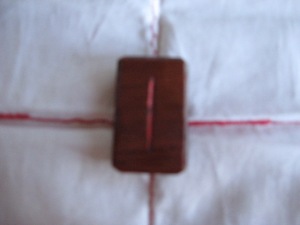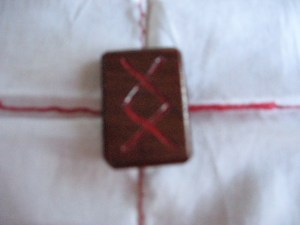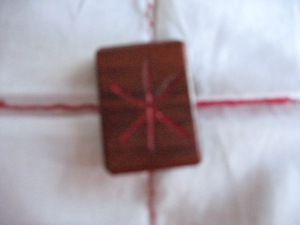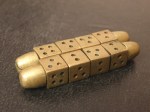Now that you are familiar with the signs and the charts, let’s look at how to interpret the chart in order to get answers.
First we will examine the shield chart.
The most basic way to interpret the shield chart is to look at the Judge. In a simple yes or no question, the judge will provide the answer. When you handle more complex questions, the judge is still the primary figure to look at, as the favorable or unfavorable nature of the judge will color the whole of the answer.
What is a favorable sign? Well that depends upon the question. However, the names should give you an idea of what is favorable. As there are only 8 possible judges which are made up of the previously listed impartial figures, it can be pretty easy to break it down.
To recap, here are the only figures who can be judges
Populus, Via, Carcer, Conjunctio, Amissio, Acquisitio, Fortuna Major, Fortuna Minor
In a general sense we can say that Fortuna Major and Acquisitio are fortunate in most things. The other two figures that could be seen as generally fortunate are Populus and Conjunctio. But again, this depends upon the question. For example, if the issue is regarding being released from prison, Fortuna Major is a bad sign, as it indicates slow progress, although, you will eventually be released, and probably be well and whole, but it may take a while. If you want to lose something, then Acquisitio would not be favorable either, because it indicates gain and increase.
So, it stands to follow that the general unfavorable signs are Via, Carcer, Amissio and Fortuna Minor. Via is seen as unfavorable because it indicates changes, which can cause good things to turn bad (although bad things can also turn good, but it seems the first quality is more emphasized) Carcer or Prison because it indicates solitude, confinement and restriction, Amissio because it signifies loss and losing things, both physical and metaphysical. Fortuna Minor is considered bad because it is less than Fortuna Major. It also indicates a short term or short lived fortune, one that could be quickly lost, or that has a limited window of opportunity. But, again, it depends upon the question. If you want to lose something, Amissio is your good friend. If you want to be alone, Carcer is going in your favor.
Past Present Future
You can read the Past, Present and Future from a Geomantic shield chart. The common method and perhaps traditional method is in looking at the Right Witness, the Judge, and the Left Witness. The Right Witness is the Past, the Judge is the Present, and the Left WItness is the Future.
Personally, I don’t favor that method. To me, it doesn’t line up with the flow of the chart in how it presents things.
I like to see the witnesses, both right and left, as the past. The Right Witness is the client’s personal past. The left Witness is the Environment around the client and its past. Obviously it is possible that a fortunate client and a supportive environment could create a fortunate present. But just as well, many combinations could create a fortunate or helpful present situation. The present is indicated by the Judge. This is after all, the culmination of all the prior figures and will indicate the impartial situation that the client is dealing with. The future is indicated by the Sentence (ie adding the 1st Mother with the Judge together). It is kind of a deep symbolism for me that the future is indicated by using the 1st Mother, the kind of primal seed figure for the chart when combined with the present, indicated by the Judge, creates the future, as indicated by the Sentence.
If you don’t wish to calculate the Sentence, as some people don’t, another method that I prefer is to read the Left Witness as the Present, and the Judge as the Future. It is for me, a feeling of how the chart flows and leaves the Judge as the ultimate decider, giving indications of how your desired or undesired actions may turn out.
Way of Points
There are two other practices that can be done in the shield chart that I feel are simple and easy to understand. The first of these is called the Way of Points of Via Puncti in Latin. This simple process is done by looking at the headline in the Judge and then examining the head lines in the Right and Left Witnesses. If the headlines match up (that is, if they are single points or double points) you then progress to the next row of signs, the nieces. If the niece’s heads match with the witnesses, you then progress to the Mothers and Daughters Line. Any Mothers or Daughters that match give indications of subtle, underlying or hidden influences in the Shield chart. If the head lines don’t match, that is the end point and you don’t move on. So, if the Head Line of the Judge doesn’t match the Witnesses, you don’t progress to the next higher level. That serves as a further indicator showing that everything is up front and forward, and there are no hidden or subtle motives or actions in relation to the client’s question or situation.
An interesting quirk of geomancy is that when the Way of Points is formed, the single point will always start it, and it will always lead back to one specific figure in the Mothers or Daughters. One and Only one. If the head line has two points in the judge, it is possible that every mother and daughter could be indicated. It could just as easily stop short in the witnesses, or nieces as well. This is a handy technique to know and use if it seems like there is more going on than the client indicates.
Sum of Points
Another useful technique is called the sum of points. Similar to the Index and Point of Fortune in the House Chart, the sum of points involves counting all the points in all the figures in every line, including the sentence if you have one. The sum total of the points gives an indication to the nature of the chart. This indication is in relation to the number 96. 96 is the total sum of every point of all 16 figures. If the sum of points in the chart is less than 96, this indicates a quick but unstable resolution to the client’s question. If the sum is equal to 96, this indicates a resolution will come without slowness or obstacle or doubt and will be stable and reliable. If the sum is greater than 96, this indicates that the resolution will experience delays, and only resolve slowly. That resolution will also be fixed, regardless of favorability of the outcome.
There is an additional interpretation technique known as the four Triplicities. However, it is not as simple, and can easily fill a post explaining it as well, and will be explained in the future..
Examples
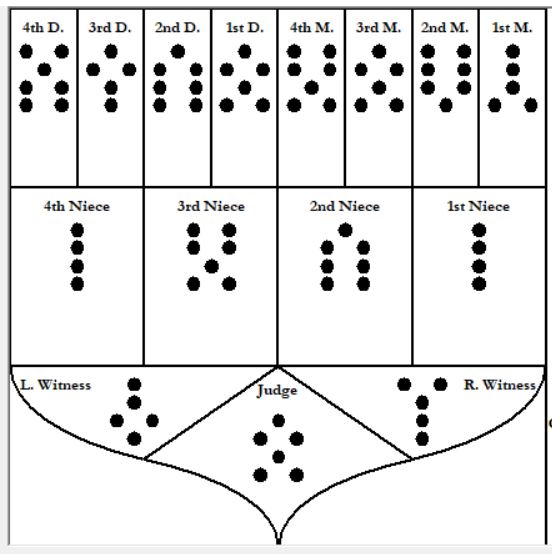
In this first example, the client is asking about if they will win a lawsuit. It is given as a simple yes or no question.
In looking at the Judge, the figure is Amissio, indicating Loss. In regards to their question the answer is No, they will lose this lawsuit.
For more information you can look at the Witnesses. The Right Witness indicates the client who is asking the question. They are indicated by Caput Draconis, The Dragon’s Head. This is generally a favorable figure, indicating new beginnings and positive results. The client has some pretty high hopes for their lawsuit.
The Left Witness indicates their opponent in the lawsuit, aka the Defendant. In this case the defendant is indicated by Puer, the Boy. This indicates that the opponent is strong and energetic, they use their intellect and in this situation are rather unemotional. This is also a figure of Mars, a planet associated with conflict and conquest, including legal battles. This explains why the defendant is going to win. They are just stronger and more powerful than the client is. It confirms the Judge of Amissio, indicating loss.
Example #2
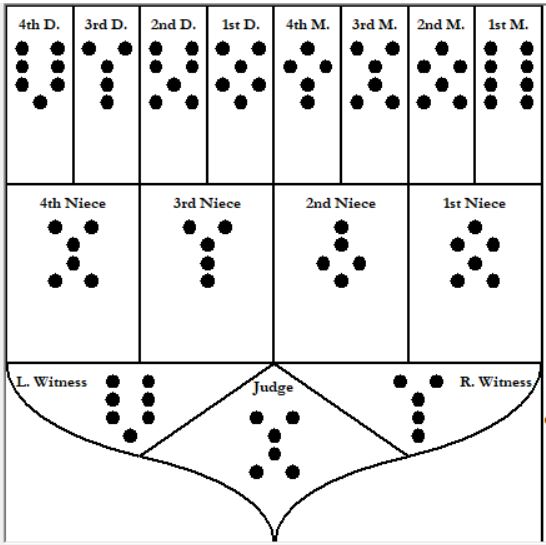
In this example, the client is asking if their dream is significant and if they should heed what they dreamed of. They didn’t wish to provide details to the geomancer, but only wanted an answer.
The judge in this chart is Conjunctio. As a simple yes or no, Conjunctio does fall into the more favorable indication, but it’s not very strong. This is where looking more into the chart in order to clarify the answer is needed.
In looking at the Right Witness as the Client, we again have Caput Draconis. This client is hopeful and looking for a positive outcome. The Left Witness gives us Tristitia. While this indicates sadness, it also indicates the keeping of secrets. Whatever this client is sitting on, they are not giving up their secrets easily. The dream itself may involve a secret that they are keeping, and its significance may have something to do with that. This still doesn’t really give us an answer to the question however.
Using the Way of Points, we can track the head line of Conjunctio, leading to the 4 daughters ultimately, and the Right Witness. That it goes to the Right Witness really underscores that this is something very personal and close to the client. The Four Daughters (from right to left) are Acquisitio, Albus, Caput Draconis, and Tristitia. This repeats the pattern found in the witnesses, but with additional information. Acquisitio indicates Gain and acquiring something, while Albus indicates peace, purity, rest and intellect. Acquisitio gives a greater indication of a positive response to the client’s answer. Albus is also considered favorable, but weak, requiring assistance to bring favorable results. It may also give an indication of what the dream was about, something was gained, that is giving the client rest. Conjunctio may help explain it as a meeting. Perhaps the client was reunited in a dream with a lost loved one who passed away. The dream may have indicated that the loved one is at peace, and free from pain and suffering, and wished to also convey this message to the client. While the client is hopeful for a positive message, their grief over the passing wracks them with doubt, and so they sought out someone to give an answer to their question brought on by the dream. The answer to give is yes, the dream was significant and you should heed the message given to you.
Example #3
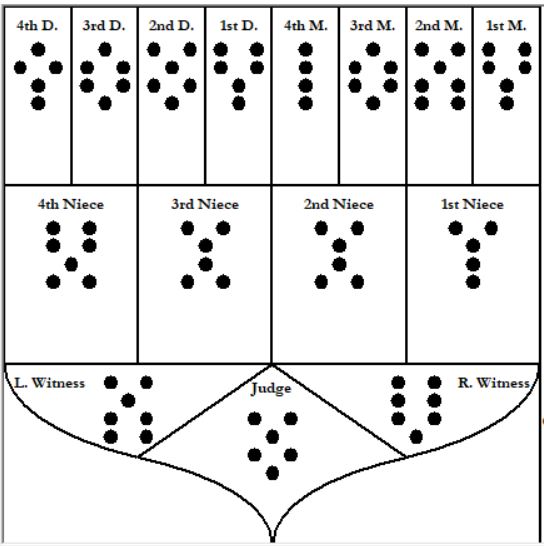
The next example is a question regarding real estate. The clients wish to buy property for a home, and if they will succeed in gaining what they desire.
The Judge in this question is Acquisitio. From a simple answer, it is quite clear that the clients will succeed in their goal. However, the clients want more information, not just a quick yes. To that we will look to the Past, Present, and Future, and the Sum of Points for this Question. We will also include the Reconciler or Sentence to give further information and clarity.
In the Right and Left Witnesses we see the client’s past. To the Right, Tristitia. To the Left, Rubeus. The client’s pasts have not been easy. Tristitia indicates sadness, suggesting that they have been dealing with some heavy stuff. Rubeus is easily considered one of the most evil of signs, Violence, Bloodshed, Perversion, Addiction are all indicated by Rubeus. There is one sliver of goodness from Tristitia however. It also indicates secrets, and laying solid foundations. One could interpret that even while all the bad stuff was going on, they have been hiding away money, saving up in order to get something, laying the foundation for something new. Preparing to take themselves away from the awful experiences of their past.
The Present is indicated by Acquisitio. This indicates Gain, and is the second most fortunate sign. They will get what they want.
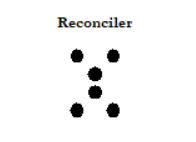 The Reconciler or Sentence is Conjunctio. This indicates a meeting and coming together. In seeing that their 1st Mother is Fortuna Major meeting with Acquisitio, the two most fortunate figures in geomancy, this meeting indicates that Great Luck and Gain will meet, probably creating the life they have dreamed for, and being able to put the ugliness of the past behind them. Truly a blessing.
The Reconciler or Sentence is Conjunctio. This indicates a meeting and coming together. In seeing that their 1st Mother is Fortuna Major meeting with Acquisitio, the two most fortunate figures in geomancy, this meeting indicates that Great Luck and Gain will meet, probably creating the life they have dreamed for, and being able to put the ugliness of the past behind them. Truly a blessing.
The sum of points in this chart, including the Reconciler is 96. This is truly a fantastical chart. They won’t have delays, and things will turn out in good time, and without doubt. When they do acquire their house, it will be theirs completely, and be a stable and lasting gain for them.
This chart is also an example of the Way of Points, when every Mother and Daughter is indicated. This suggests that a lot of situations and forces and effort have been put into what they have been working for. While it has been difficult, it is all going to pay out in a big and wonderful way for them.
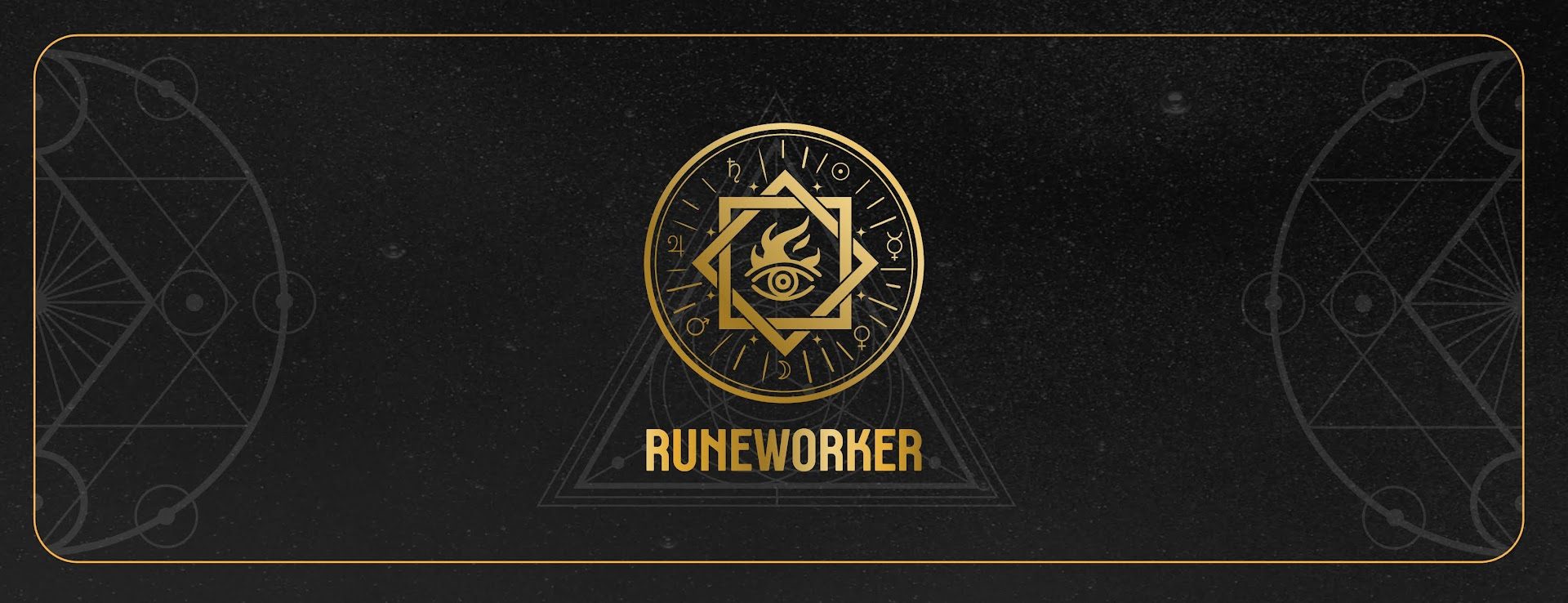
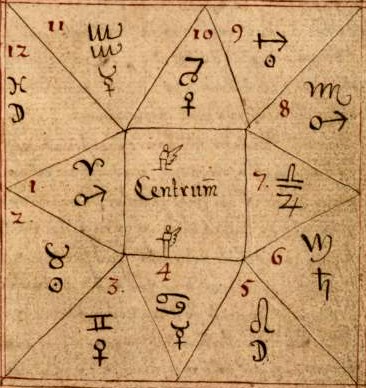
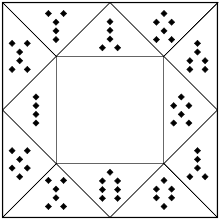
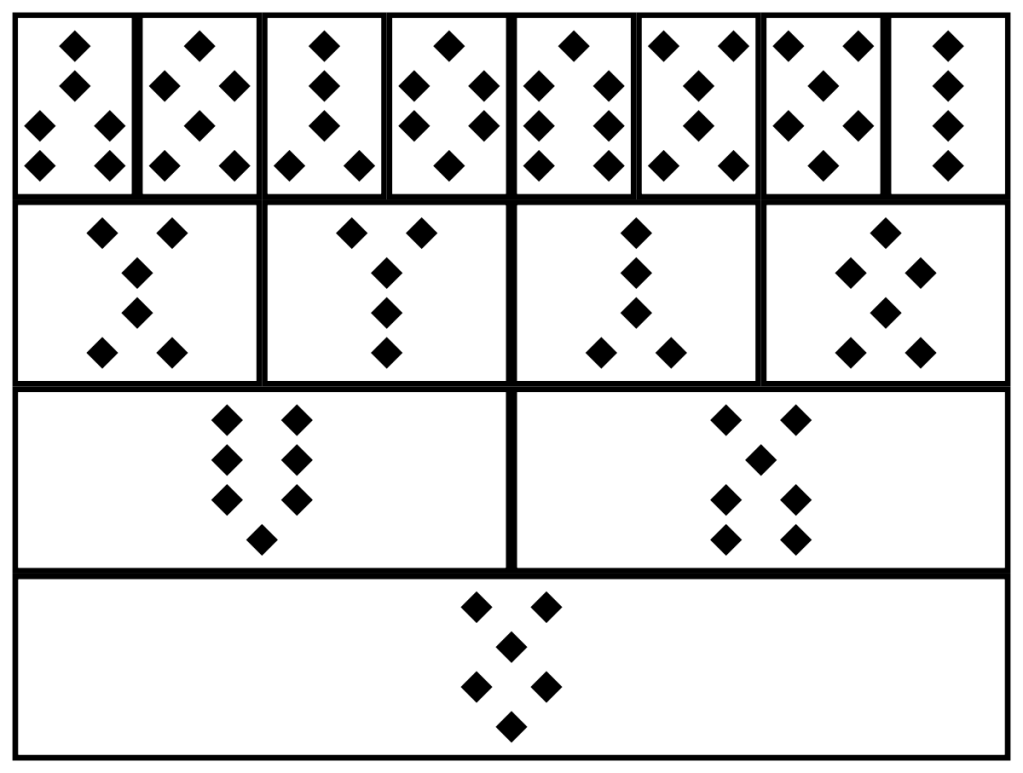

 In Geomancy, we use sixteen signs that are interpreted to give indications. These signs are made up of four lines in which there are either one or two dots. It is essentially like binary code, in that you could consider the single dot indicates something as being “on” or active and the two dots is the equivalent of “off” or “inactive”. This combination of dots shapes the figures.
In Geomancy, we use sixteen signs that are interpreted to give indications. These signs are made up of four lines in which there are either one or two dots. It is essentially like binary code, in that you could consider the single dot indicates something as being “on” or active and the two dots is the equivalent of “off” or “inactive”. This combination of dots shapes the figures. Puer (Latin for Youth, or a Adolescent Male) – Inner element Air: Outer element: Fire Planet: Mars Sign: Aries Mobile Exiting, Partial
Puer (Latin for Youth, or a Adolescent Male) – Inner element Air: Outer element: Fire Planet: Mars Sign: Aries Mobile Exiting, Partial Puella (Latin for Maiden or an Adolescent Female) – Inner element: Air Outer Element: Water Planet: Venus Sign: Libra Stable Entering Partial
Puella (Latin for Maiden or an Adolescent Female) – Inner element: Air Outer Element: Water Planet: Venus Sign: Libra Stable Entering Partial Albus ( Latin for White) -Inner Element: Water Outer Element: Air Planet: Mercury Sign: Gemini Stable, Entering Partial
Albus ( Latin for White) -Inner Element: Water Outer Element: Air Planet: Mercury Sign: Gemini Stable, Entering Partial Rubeus (Latin for Red) – Inner Element: Air Outer Element: Water Planet: Mars Sign: Scorpio Mobile, Exiting, Partial
Rubeus (Latin for Red) – Inner Element: Air Outer Element: Water Planet: Mars Sign: Scorpio Mobile, Exiting, Partial Amissio (Latin for Loss) – Inner Element: Fire Outer Element: Earth Planet: Venus Sign: Taurus Mobile, Exiting, Impartial
Amissio (Latin for Loss) – Inner Element: Fire Outer Element: Earth Planet: Venus Sign: Taurus Mobile, Exiting, Impartial  Aquisitio (Latin for Gain) – Inner Element: Air Outer Element: Fire Planet: Jupiter Sign: Sagittarius Stable, Entering, Impartial
Aquisitio (Latin for Gain) – Inner Element: Air Outer Element: Fire Planet: Jupiter Sign: Sagittarius Stable, Entering, Impartial Populus (People or Crowds) – Inner Element: Outer Element Water: Planet: Moon Sign: Cancer Stable, Both, Impartial
Populus (People or Crowds) – Inner Element: Outer Element Water: Planet: Moon Sign: Cancer Stable, Both, Impartial Via (The Way or Road) – Inner Element: Outer Element: Water Planet: Moon Sign: Cancer Mobile, Both, Impartial
Via (The Way or Road) – Inner Element: Outer Element: Water Planet: Moon Sign: Cancer Mobile, Both, Impartial Carcer (Latin for Prison) – Inner Element: Earth Outer Element Earth: Planet: Saturn Sign: Capricorn Stable, Both, Impartial
Carcer (Latin for Prison) – Inner Element: Earth Outer Element Earth: Planet: Saturn Sign: Capricorn Stable, Both, Impartial Conjunctio (Latin for Conjunction) aka a Meeting or Crossroads – Inner Element: Air Outer Element: Earth Planet:Mercury Sign: Virgo Mobile Both Impartial
Conjunctio (Latin for Conjunction) aka a Meeting or Crossroads – Inner Element: Air Outer Element: Earth Planet:Mercury Sign: Virgo Mobile Both Impartial Fortuna Major (Latin for Greater Fortune) – Inner Element:Earth Outer Element: Fire Planet: Sun Sign: Leo Stable, Entering, Impartial
Fortuna Major (Latin for Greater Fortune) – Inner Element:Earth Outer Element: Fire Planet: Sun Sign: Leo Stable, Entering, Impartial Fortuna Minor (Latin for Lesser Fortune) – Inner Element: Fire Outer Element: Fire Planet: Sun Sign: Leo Mobile, Exiting, Impartial
Fortuna Minor (Latin for Lesser Fortune) – Inner Element: Fire Outer Element: Fire Planet: Sun Sign: Leo Mobile, Exiting, Impartial Laetitia (Latin for Joy) – Inner Element: Fire Outer Element: Water Planet:Jupiter Sign: Pisces Mobile, Exiting, Partial
Laetitia (Latin for Joy) – Inner Element: Fire Outer Element: Water Planet:Jupiter Sign: Pisces Mobile, Exiting, Partial Tristitia (Latin for Sadness) – Inner Element: Earth Outer Element: Air Planet: Saturn Sign: Aquarius Stable, Entering Partial
Tristitia (Latin for Sadness) – Inner Element: Earth Outer Element: Air Planet: Saturn Sign: Aquarius Stable, Entering Partial Caput Draconis (Latin for Head of the Dragon) – Inner Element: Earth Outer Element: Earth Planet North Node of the Moon: Sign: Virgo Stable, Entering Partial
Caput Draconis (Latin for Head of the Dragon) – Inner Element: Earth Outer Element: Earth Planet North Node of the Moon: Sign: Virgo Stable, Entering Partial Cauda Draconis (Latin for Tail of the Dragon) – Inner Element: Fire Outer Element: Fire Planet: South Node of the Moon Sign: Sagittarius Mobile, Exiting, Partial
Cauda Draconis (Latin for Tail of the Dragon) – Inner Element: Fire Outer Element: Fire Planet: South Node of the Moon Sign: Sagittarius Mobile, Exiting, Partial
